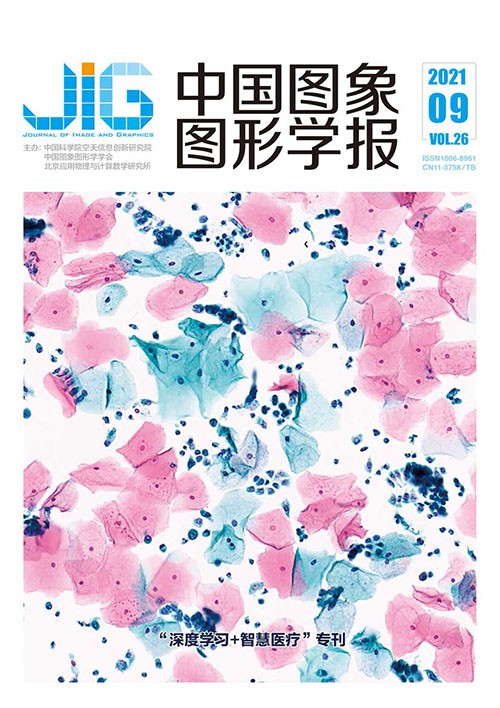
视觉显著性的眼底图像视盘检测
摘 要
目的 青光眼是导致失明的主要疾病之一,视盘区域的形状、大小等参数是青光眼临床诊断的重要指标。然而眼底图像通常亮度低、对比度弱,且眼底结构复杂,各组织以及病灶干扰严重。为解决上述问题,实现视盘的精确检测,提出一种视觉显著性的眼底图像视盘检测方法。方法 首先,依据视盘区域显著的特点,采用一种基于视觉显著性的方法对视盘区域进行定位;其次,采用全卷积神经网络(fully convolutional neural network,FCN)预训练模型提取深度特征,同时计算视盘区域的平均灰度,进而提取颜色特征;最后,将深度特征、视盘区域的颜色特征和背景先验信息融合到单层元胞自动机(single-layer cellular automata,SCA)中迭代演化,实现眼底图像视盘区域的精确检测。结果 在视网膜图像公开数据集DRISHTI-GS、MESSIDOR和DRIONS-DB上对本文算法进行实验验证,平均相似度系数分别为0.965 8、0.961 6和0.971 1;杰卡德系数分别为0.934 1、0.922 4和0.937 6;召回率系数分别为0.964 8、0.958 9和0.967 4;准确度系数分别为0.996 6、0.995 3和0.996 8,在3个数据集上均可精确地检测视盘区域。实验结果表明,本文算法精确度高,鲁棒性强,运算速度快。结论 本文算法能够有效克服眼底图像亮度低、对比度弱及血管、病灶等组织干扰的影响,在多个视网膜图像公开数据集上进行验证均取得了较好的检测结果,具有较强的泛化性,可以实现视盘区域的精确检测。
关键词
Optic disc detection based on visual saliency in fundus image
Lyu Pengfei1, Wang Ying1, Wang Siqi1, Yu Xiaosheng2, Wu Chengdong2(1.College of Information Science and Engineering, Northeastern University, Shenyang 110819, China;2.Faculty of Robot Science and Engineering, Northeastern University, Shenyang 110819, China) Abstract
Objective Glaucoma is a type of disease characterized by atrophy and depression of the nipple, visual field defect, and visual loss. It is one of the main diseases that cause blindness and visual impairment. The clinical diagnosis of glaucoma includes the optic disc, optic cup, intraocular pressure, and the angle between the cornea and iris. Early detection and treatment are crucial for avoiding visual impairment and blindness. In a fundus image, the optic disc is a bright yellow-white spot that resembles a circle, and it is the birthplace of the fundus blood vessels. The shape, size, and depth of the optic disc area and other parameters are important indicators in the clinical diagnosis of glaucoma. Detection of the optic disc can also help determine the location of other lesions, such as fundus hemorrhage and micro aneurysm. Thus, precise detection of the optic disc area is also vital. However, the fundus image is often not bright, and its contrast is poor. In addition, the fundus structure is complex, and the overlapping of tissues and lesions is serious. These problems pose great challenges to the accurate detection and segmentation of the optic disc. The traditional single visual saliency method is considerably affected by color and brightness; hence, tissues, such as blood vessels, and bright lesions easily interfere in optic disc detection. Fully convolutional neural networks (FCNs) classify images at the pixel level, thus solving the problem of image segmentation at the semantic level. In the process of FCN optic disc testing, the detection results are minimally affected by tissues (e.g., vascular lesions), the borders are rough, and the accuracy is low. To overcome these difficulties and achieve accurate detection of the fundus image optic disc, this study combines the advantages of the visual saliency method and FCN, and a visual saliency disc detection method based on the fusion of deep and shallow features is proposed. Method First, on the basis of the prominent characteristics of the optic disc area, a method based on visual saliency detection is used to locate the optic disc area. The saliency detection method based on morphological open reconstruction is utilized to extract the candidate solutions of the optic disc so that the enhanced optic disc becomes conspicuous and appears as a bright circular structure. The center of gravity of the optic disc is obtained and marked, and an image with a pixel size of 400×400 with the center of gravity as the center is extracted to segment the optic disc. Second, the Matconvnet computer vision neural network toolbox is used to extract deep features from the pre-trained model. The pre-trained model uses the pascal-fcn8s-dag.mat file provided on the official website of the Matconvnet toolbox, which uses the PASCAL VOC (pattern analysis, statistical modeling and computational learning visual object classes) 2011 dataset for training. Moreover, the average grayscale of the disc area is calculated for the 400×400 pixel size images to obtain color features. Lastly, by fusing the color feature, depth feature, and background prior information into a single-layer cellular automaton, the similarity is judged based on the distance between different cells in the feature space. Iterative evolution is performed to achieve accurate detection of the optic disc area in the fundus image. Result The proposed algorithm is experimentally verified on public datasets of fundus images, namely, DRISHTI-GS, MESSIDOR, and DRIONS-DB. The three datasets are mainly used for optic nerve head detection, including optic cup and optic disc. The optic disc area can be accurately detected in all datasets. The proposed algorithm detects the optic disc area in these datasets, and the evaluation indicators include Dice, Jaccard, recall, and accuracy. In the DRISHTI-GS dataset, Dice is 0.965 8, Jaccard is 0.934 1, recall is 0.964 8, and accuracy is 0.996 6. In the MESSIDOR dataset, Dice, Jaccard, recall, and accuracy have values of 0.961 6, 0.922 4, 0.958 9, and 0.995 3, respectively. In the DRIONS-DB dataset, Dice is 0.971 1, Jaccard is 0.937 6, recall is 0.967 4, and accuracy is 0.996 8. In addition, the proposed algorithm is compared with three algorithms, namely, improved circular Hough transform with Hough peak value selection and red channel superpixel segmentation for optic disc segmentation, accurate optic disc and cup segmentation from fundus images by using a multi-feature-based approach for glaucoma assessment, and dense fully convolutional with U-shape segmentation of the optic disc and cup in color fundus for glaucoma diagnosis. The proposed algorithm has higher accuracy, robustness, and calculation speed than the compared algorithms. Conclusion We propose a single-layer cellular automaton optic disc detection algorithm that integrates deep and shallow features. Experimental results show that the proposed algorithm can effectively overcome the effects of low brightness and low contrast of fundus images and the interference of blood vessels, lesions, and other tissues. The algorithm is verified on multiple public datasets of fundus images and achieves good detection results. It has strong generalization and realizes accurate detection of the optic disc area.
Keywords
|



 中国图象图形学报 │ 京ICP备05080539号-4 │ 本系统由
中国图象图形学报 │ 京ICP备05080539号-4 │ 本系统由